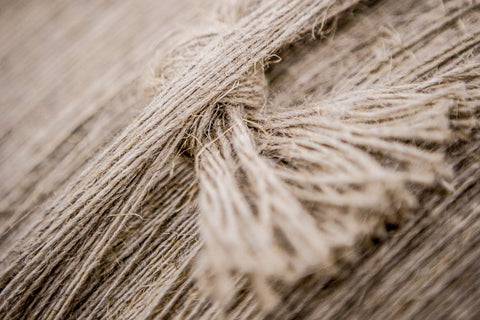Tea towel define "a cloth for drying dishes.", definitely a Kitchen essential.
Often made of linen, cotton, or a combination of the two, tea towels date back to England in the 18th century, when they were used to insulate tea pots at tea ceremonies (hence the name), dry fine china, and cover baked goods.
Strangely, finding a thick and thirsty tea towel is not that simple nowadays. I personally tried MANY with limited results and the same frustration of not drying my dishes properly when I don't have time for gravity to do the job... Plus, at times, your glasses can be covered with lint... making me wonder...
How come? What are the tricks? Why did my mum have proper tea towels while I can't find any??? There must be an explanation... and therefore a need for investigation.
What textile to choose?
I thought I had to go for waffle weave structure and thick fabrics to improve absorbency. I have a little collection and yet, not very satisfied... It should improve the drying properties but other parameters are obviously involved...
I wondered whether the fabric itself played a very important role there too and researched for the best fabric to use for tea towels. Tea towels need to be made from absorbent materials. Skip the man-made fibers like polyester and use natural fibers like linen and cotton for soft and absorbent tea towels.
The drying properties of pure linen are renowned to be far superior to cotton and improve with use. Linen is also a stronger fabric than cotton and therefore can withstand the abrasive action of rubbing.

Looking at what professionals use, I found chefs use tightly-woven towels for heavy kitchen use. This not only allows them to be more durable, but also enables them to be lint-free. Loosely-woven towels tend to shed after just a few uses, but tight weave designs prevent lint... Worth knowing!
So, I went for Linen tea towels... and wanted to do the right thing with this right product...
How to take care of Tea towels?
Another rule to keep in mind is that before using any textile for the first time, you should wash them. Tea Towels are no exception. You sometimes give it a go anyway and you end up giving up because it is just so not working!!!!
THE IMPORTANCE OF THE FIRST WASH
Yes, as pretty as they may look, new tea towels are not very absorbent because of the excess dye and oils left over from the manufacturing process. Indeed, brand new towels have a coating applied by the manufacturer that can reduce how well they absorb.
To combat this, you can wash your lovely new tea towels with warm water before you first use them. Use diluted white vinegar in that first wash as this helps improve the absorbency of your tea towel even more and will prevent its colors from running during the wash.

Luckily, being pre-washed my tea towels were ready to do the job and I could skip this 1st wash step. However, I started to love them so much that I wanted to keep them forever this way! I wondered about the proper care tea towels should get to maintain their drying properties...
PROPERLY CARING FOR TEA TOWELS
For towels you've had a while, the laundry products you're using can make your dish towels not absorbent. A buildup of detergent or unfortunately fabric conditioner can make your tea towels less absorbent by coating them in a layer of water-resistant oil so it’s best to only use a bit detergent when washing them.
With added effects from enzymes, biological detergents can break down protein, fats, and starches in food stains at lower temperatures (no hotter than 50 degrees centigrade is the recommendation). Otherwise, simply use Ox Gall Soap on food stains prior to washing your tea towels.
DEALING WITH SMELLS
If you sometimes find your tea towels still smells even after washing, try adding white vinegar or baking soda (Bicarbonate) to your wash as well as detergent. For the best results, pause your wash half way through, let it soak for as long as possible (preferably overnight), then restart the cycle.
KEEPING THE COLOR
You can also maximise your tea towel’s colour longevity by adding some baking soda to your washes and white vinegar to the rinse cycle. Just make sure you don’t put vinegar in the same cycle as the washing powder or baking soda as they will neutralise each other and not work.
DRYING AND IRONING
Drying your tea towels on a line is much better for them than a tumble dryer. Just make sure you face the printed side away from the sun, as the light will cause fading. And, ideally you should steam iron your towels while they are still damp and ensure you iron them on the reverse.
Ta da! Now, I know what to choose and what to do... Is this taught in schools??? No more frustration but happiness of having something that does the job extremely well, which is making my life easier at the same time.
I am convinced I have finally (!!!!) picked the right tea towels! Top Quality, very resistant, timeless and natural. With proper maintenance, they finally do the job and will last a lifetime, making the price a really good investment with long term in mind. Hope you will enjoy them too!
Check out our new French linen goodies and Bliss Yourself!


